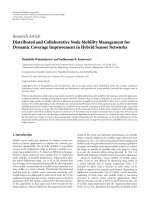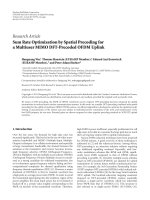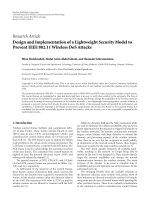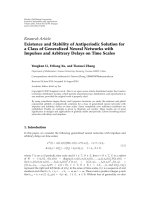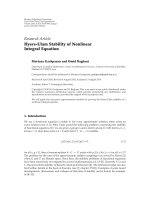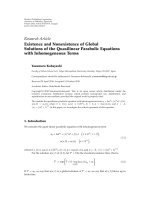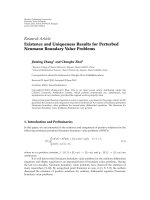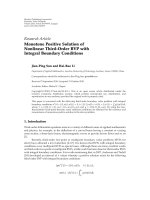báo cáo hóa học:" Research Article Existence and Uniqueness of Periodic Solutions for a Class of Nonlinear Equations with p-Laplacian-Like Operators" doc
Bạn đang xem bản rút gọn của tài liệu. Xem và tải ngay bản đầy đủ của tài liệu tại đây (499.79 KB, 11 trang )
Hindawi Publishing Corporation
Advances in Difference Equations
Volume 2010, Article ID 197263, 11 pages
doi:10.1155/2010/197263
Research Article
Existence and Uniqueness of Periodic
Solutions for a Class of Nonlinear Equations with
p-Laplacian-Like Operators
Hui-Sheng Ding, Guo-Rong Ye, and Wei Long
College of Mathematics and Information Science, Jiangxi Normal University, Nanchang,
Jiangxi 330022, China
Correspondence should be addressed to Wei Long,
Received 1 February 2010; Accepted 19 March 2010
Academic Editor: Gaston Mandata N’Guerekata
Copyright q 2010 Hui-Sheng Ding et al. This is an open access article distributed under the
Creative Commons Attribution License, which permits unrestricted use, distribution, and
reproduction in any medium, provided the original work is properly cited.
We investigate the following nonlinear equations with p-Laplacian-like operators ϕx
t
fxtx
tgxt et: some criteria to guarantee the existence and uniqueness of periodic
solutions of the above equation are given by using Mawhin’s continuation theorem. Our results
are new and extend some recent results due to Liu B. Liu, Existence and uniqueness of periodic
solutions for a kind of Lienard type p-Laplacian equation, Nonlinear Analysis TMA, 69, 724–729,
2008.
1. Introduction
In this paper, we deal with the existence and uniqueness of periodic solutions for the
following nonlinear equations with p-Laplacian-like operators:
ϕ
x
t
f
x
t
x
t
g
x
t
e
t
,
1.1
where f, g are continuous functions on R,ande is a continuous function on R with period
T>0; moreover, ϕ : R → R is a continuous function satisfying the following:
H1 for any x
1
,x
2
∈ R,x
1
/
x
2
, ϕx
1
− ϕx
2
· x
1
− x
2
> 0andϕ00;
H2 there exists a function α : 0, ∞ → 0, ∞ such that lim
s → ∞
αs∞ and
ϕ
x
· x ≥ α
|
x
|
|
x
|
, ∀x ∈ R. 1.2
2 Advances in Difference Equations
It is obvious that under these two conditions, ϕ is an homeomorphism from R onto R and is
increasing on R.
Recall that p-Laplacian equations have been of great interest for many mathematicians.
Especially, there is a large literature see, e.g., 1–7 and references therein about the existence
of periodic solutions to the following p-Laplacian equation:
ϕ
p
x
t
f
x
t
x
t
g
x
t
e
t
,
1.3
and its variants, where ϕ
p
s|s|
p−2
s for s
/
0andϕ
p
00. Obviously, 1.3 is a special case
of 1.1.
However, there are seldom results about the existence of periodic solutions to 1.1.
The main difficulty lies in the p-Laplacian-like operator ϕ of 1.1, which is more complicated
than ϕ
p
in 1.3. Since there is no concrete form for the p-Laplacian-like operator ϕ of 1.1,it
is more difficult to prove the existence of periodic solutions to 1.1.
Therefore, in this paper, we will devote ourselves to investigate the existence of
periodic solutions to 1.1. As one will see, our theorem generalizes some recent results even
for the case of ϕsϕ
p
ssee Remark 2.2.
Next, let us recall some notations and basic results. For convenience, we denote
C
1
T
:
x ∈ C
1
R, R
: x is T-periodic
, 1.4
which is a Banach space endowed with the norm x max{|x|
∞
, |x
|
∞
}, where
|
x
|
∞
max
t∈0,T
|
x
t
|
,
x
∞
max
t∈0,T
x
t
.
1.5
In the proof of our main results, we will need the following classical Mawhin’s
continuation theorem.
Lemma 1.1 8. Let (H1), (H2) hold and
f is Carath
´
eodory. Assume that Ω is an open bounded set
in C
1
T
such that the following conditions hold.
S1 For each λ ∈ 0, 1, the problem
ϕ
x
t
λ
f
t, x, x
,x
0
x
T
,x
0
x
T
1.6
has no solution on ∂Ω.
S2 The equation
F
a
:
1
T
T
0
f
t, a, 0
dt 0
1.7
has no solution on ∂Ω ∩ R.
S3 The Brouwer degree
deg
F, Ω ∩ R, 0
/
0. 1.8
Advances in Difference Equations 3
Then the periodic boundary value problem
ϕ
x
t
f
t, x, x
,x
0
x
T
,x
0
x
T
1.9
has at least one T-periodic solution on
Ω.
2. Main Results
In this section, we prove an existence and uniqueness theorem for 1.1.
Theorem 2.1. Suppose the following assumptions hold:
A1 g ∈ C
1
R, R and g
x < 0 for all x ∈ R;
A2 there exist a constant r ≥ 0 and a function εt ∈ CR, R such that for all t ∈ R and
|x| >r,
x
g
x
− ε
t
< 0,
T
0
ε
t
− e
t
dt ≤ 0,
T
0
|
ε
t
− e
t
|
dt < 2.
2.1
Then 1.1 has a unique T-periodic solution.
Proof
Existence. For the proof of existence, we use Lemma 1.1. First, let us consider the homotopic
equation of 1.1:
ϕ
x
t
λf
x
t
x
t
λg
x
t
λe
t
,λ∈
0, 1
.
2.2
Let xt ∈ C
1
T
be an arbitrary solution of 2.2. By integrating the two sides of 2.2
over 0,T, and noticing that x
0x
T and x0xT, we have
T
0
g
x
t
− e
t
dt 0,
2.3
that is,
1
T
T
0
g
x
t
dt e :
1
T
T
0
e
t
dt.
2.4
Since gx· is continuous, there exists t
0
∈ 0,T such that
g
x
t
0
≥
e. 2.5
4 Advances in Difference Equations
In view of A1,weobtain
x
t
0
≤ e, 2.6
where e g
−1
e. Then, for each t ∈ t
0
,t
0
T, we have
2x
t
x
t
x
t − T
x
t
0
t
t
0
x
s
ds x
t
0
−
t
0
t−T
x
s
ds
≤ 2x
t
0
t
t
0
x
s
ds
t
0
t−T
x
s
ds
≤ 2e
T
0
x
s
ds,
2.7
which gives that
|
x
|
∞
≤ e
1
2
T
0
x
s
ds.
2.8
Thus,
|
x
|
∞
≤
|
e
|
1
2
T
0
x
s
ds.
2.9
Since lim
s → ∞
αs∞, there is a constant M>0 such that
α
s
≥ 1, ∀s ≥ M. 2.10
Set
E
1
t : t ∈
0,T
,
x
t
>M
,E
2
t : t ∈
0,T
,
x
t
≤ M
,
F
1
{
t : t ∈
0,T
,
|
x
t
|
>r
}
,F
2
{
t : t ∈
0,T
,
|
x
t
|
≤ r
}
.
2.11
In view of A2 and
ϕ
x
· x ≥ α
|
x
|
|
x
|
, ∀x ∈ R, 2.12
Advances in Difference Equations 5
we get
T
0
x
t
dt
E
1
x
t
dt
E
2
x
t
dt
≤
E
1
x
t
dt MT
≤
E
1
ϕ
x
t
x
t
α
|
x
t
|
dt MT
≤
E
1
ϕ
x
t
x
t
dt MT
≤
T
0
ϕ
x
t
x
t
dt MT
T
0
ϕ
x
t
dx
t
MT
−
T
0
ϕ
x
t
x
t
dt MT
λ
T
0
g
x
t
− e
t
x
t
dt λ
T
0
f
x
t
x
t
x
t
dt MT
λ
T
0
g
x
t
− e
t
x
t
dt MT
λ
F
1
g
x
t
− ε
t
x
t
dt λ
F
2
g
x
t
− ε
t
x
t
dt
λ
T
0
ε
t
− e
t
x
t
dt MT
≤
F
2
g
x
t
− ε
t
·
|
x
t
|
dt MT
T
0
|
ε
t
− e
t
|
dt ·
|
x
|
∞
≤ M
T MT
T
0
|
ε
t
− e
t
|
dt ·
|
x
|
∞
,
2.13
where
M
max
|x|≤r
g
x
max
t∈0,T
|
ε
t
|
· r.
2.14
By 2.9, we have
|
x
|
∞
≤
|
e
|
M
M
T
2
1
2
T
0
|
ε
t
− e
t
|
dt ·
|
x
|
∞
.
2.15
6 Advances in Difference Equations
Noticing that
T
0
|
ε
t
− e
t
|
dt < 2,
2.16
there exists a constant M
> |e| such that
|
x
|
∞
≤ M
. 2.17
On the other hand, it f ollows from
ϕ
x
·
|
x
|
ϕ
x
· x ≥ α
|
x
|
|
x
|
, ∀x ∈ R, 2.18
that α|x| ≤|ϕx| for x
/
0. In addition, since x0xT, there exists t
1
∈ 0,T such that
x
t
1
0. Thus ϕx
t
1
0.
Then, for all t ∈ E : {t ∈ 0,T : x
t
/
0}, we have
α
x
t
≤
ϕ
x
t
t
t
1
ϕ
x
s
ds
≤
t
t
1
f
x
s
· x
s
ds
T
0
g
x
s
ds
T
0
|
e
s
|
ds
≤
xt
xt
1
f
u
du
max
|x|≤M
g
x
max
t∈0,T
|
e
t
|
· T
≤
M
−M
f
u
du
max
|x|≤M
g
x
max
t∈0,T
|
e
t
|
· T
≤ max
|x|≤M
f
x
· 2M
max
|
x
|
≤M
g
x
max
t∈
0,T
|
e
t
|
· T : M
.
2.19
For the above M
, it follows from lim
s → ∞
αs∞ that there exists G>M
such that
α
s
>M
,s≥ G. 2.20
Combining this with α|x
t| ≤ M
,weget
x
t
<G, t∈ E, 2.21
which yields that |x
|
∞
<G.
Now, we have proved that any solution xt ∈ C
1
T
of 2.2 satisfies
|
x
|
∞
<G,
x
∞
<G. 2.22
Advances in Difference Equations 7
Since G>|e|, we have
G>e g
−1
e
, −G<e g
−1
e
.
2.23
In view of g being strictly decreasing, we get
g
G
<
e, g
−G
> e 2.24
Set
Ω
x ∈ C
1
T
:
|
x
|
∞
≤ G,
x
∞
≤ G
. 2.25
Then, we know that 2.2 has no solution on ∂Ω for each λ ∈ 0, 1, that is, the assumption
S1 of Lemma 1.1 holds. In addition, it follows from 2.24 that
−
1
T
T
0
g
G
− e
t
dt
e − g
G
> 0,
−
1
T
T
0
g
−G
− e
t
dt
e − g
−G
< 0.
2.26
So the assumption S2 of Lemma 1.1 holds. Let
H
x, μ
μx −
1 − μ
1
T
T
0
g
x
− e
t
dt.
2.27
For x ∈ ∂Ω ∩ R and μ ∈ 0, 1,by2.24, we have
xH
x, μ
μx
2
−
1 − μ
x
1
T
T
0
g
x
− e
t
dt
μx
2
1 − μ
x
1
T
T
0
e − g
x
dt > 0.
2.28
Thus, Hx, μ is a homotopic transformation. So
deg
F, Ω ∩ R, 0
deg
H
x, 0
, Ω ∩ R, 0
deg
H
x, 1
, Ω ∩ R, 0
deg
I,Ω ∩ R, 0
/
0,
2.29
that is, the assumption S3 of Lemma 1.1 holds. By applying Lemma 1.1, there exists at least
one solution with period T to 1.1.
8 Advances in Difference Equations
Uniqueness.Let
ψ
x
x
0
f
u
du, y
t
ϕ
x
t
ψ
x
t
.
2.30
Then 1.1 is transformed into
x
t
ϕ
−1
y
t
− ψ
x
t
,
y
t
−g
x
t
e
t
.
2.31
Let x
1
t and x
2
t being two T-periodic solutions of 1.1;and
y
i
t
ϕ
x
i
t
ψ
x
i
t
,i 1, 2. 2.32
Then we obtain
x
i
t
ϕ
−1
y
i
t
− ψ
x
i
t
,
y
i
t
−g
x
i
t
e
t
.
i 1, 2. 2.33
Setting
v
t
x
1
t
− x
2
t
,u
t
y
1
t
− y
2
t
, 2.34
it follows from 2.33 that
v
t
ϕ
−1
y
1
t
− ψ
x
1
t
− ϕ
−1
y
2
t
− ψ
x
2
t
,
u
t
−
g
x
1
t
− g
x
2
t
.
2.35
Now, we claim that
u
t
≤ 0, ∀t ∈ R. 2.36
If this is not t rue, we consider the following two cases.
Case 1. There exists t
2
∈ 0,T such that
u
t
2
max
t∈0,T
u
t
max
t∈R
u
t
> 0,
2.37
which implies that
u
t
2
−
g
x
1
t
2
− g
x
2
t
2
0,
u
t
2
−
g
x
1
t
− g
x
2
t
|
tt
2
−
g
x
1
t
2
x
1
t
2
− g
x
2
t
2
x
2
t
2
≤ 0.
2.38
Advances in Difference Equations 9
By A1, g
x < 0. So it follows from gx
1
t
2
− gx
2
t
2
0thatx
1
t
2
x
2
t
2
.Thus,in
view of
−g
x
1
t
2
> 0,u
t
2
y
1
t
2
− y
2
t
2
> 0, 2.39
and H1,weobtain
u
t
2
−g
x
1
t
2
x
1
t
2
− x
2
t
2
−g
x
1
t
2
ϕ
−1
y
1
t
2
− ψ
x
1
t
2
− ϕ
−1
y
2
t
2
− ψ
x
2
t
2
−g
x
1
t
2
ϕ
−1
y
1
t
2
− ψ
x
1
t
2
− ϕ
−1
y
2
t
2
− ψ
x
1
t
2
> 0,
2.40
which contradicts with u
t
2
≤ 0.
Case 2.
u
0
max
t∈0,T
u
t
max
t∈R
u
t
> 0.
2.41
Also, we have u
00andu
0 ≤ 0. Then, similar to the proof of Case 1, one can get a
contradiction.
Now, we have proved that
u
t
≤ 0, ∀t ∈ R. 2.42
Analogously, one can show that
u
t
≥ 0, ∀t ∈ R. 2.43
So we have ut ≡ 0. Then, it follows from 2.35 that
g
x
1
t
− g
x
2
t
≡ 0, ∀t ∈ R, 2.44
which implies that
x
2
t
≡ x
1
t
, ∀t ∈ R. 2.45
Hence, 1.1 has a unique T-periodic solution. The proof of Theorem 2.1 is now completed.
Remark 2.2. In Theorem 2.1, setting εt ≡ et, then A2 becomes as follows:
A2
there exists a constant r ≥ 0 such that for all t ∈ R and |x| >r,
x
g
x
− e
t
< 0. 2.46
10 Advances in Difference Equations
In the case ϕsϕ
p
s,Liu7, Theorem 1 proved that 1.1 has a unique T-periodic solution
under the assumptions A1 and A2
. Thus, even for the case of ϕsϕ
p
s, Theorem 2.1
is a generalization of 7, Theorem 1.
In addition, we have the following interesting corollary.
Corollary 2.3. Suppose A1 and
A2
there exist a constant α ≥ 0 such that
T
0
g
α
− e
t
dt ≤ 0,
T
0
g
α
− e
t
dt < 2
2.47
hold. Then 1.1 has a unique T-periodic solution.
Proof. Let εt ≡ gα. Noticing that
x
g
x
− g
α
< 0,
|
x
|
>α, 2.48
we know that A2 holds with r α. This completes the proof.
At last, we give two examples to illustrate our results.
Example 2.4. Consider the following nonlinear equation:
ϕ
x
t
f
x
t
x
t
g
x
t
e
t
,
2.49
where ϕx2xe
x
2
− 2x, fxe
−x
, gx−x
3
x,andetsin t. One can easily check
that ϕ satisfy H1 and H2. Obviously, A1 holds. Moreover, since
lim
x → ∞
g
x
−∞, lim
x →−∞
g
x
∞,
2.50
it is easy to verify that A2 holds. By Theorem 2.1, 2.49 has a unique 2π-periodic solution.
Example 2.5. Consider the following p-Laplacian equation:
ϕ
p
x
t
g
x
t
e
t
,
2.51
where gx−1/2 arctan x,andetsin
2
t. Obviously, A1 holds. Moreover, we have
π
0
g
0
− e
t
dt ≤ 0,
π
0
g
0
− e
t
dt
π
0
sin
2
t
π
2
< 2.
2.52
So A2
holds. Then, by Corollary 2.3, 2.51 has a unique π-periodic solution.
Advances in Difference Equations 11
Remark 2.6. In Example 2.5, ∀r>0, we have
x
g
x
− e
π
2
>r
1 −
π
4
> 0, ∀x<−r.
2.53
Thus, A2
does not hold. So 7, Theorem 1 cannot be applied to Example 2.5. This means
that our results generalize 7, Theorem 1 in essence even for the case of ϕsϕ
p
s.
Acknowledgments
The authors are grateful to the referee for valuable suggestions and comments, which
improved the quality of this paper. The work was supported by the NSF of China, the NSF
of Jiangxi Province of China 2008GQS0057, the Youth Foundation of Jiangxi Provincial
Education Department GJJ09456, and the Youth Foundation of Jiangxi Normal University.
References
1 S. Lu, “New results on the existence of periodic solutions to a p-Laplacian differential equation with
a deviating argument,” Journal of Mathematical Analysis and Applications, vol. 336, no. 2, pp. 1107–1123,
2007.
2 S. Lu, “Existence of periodic solutions to a p-Laplacian Li
´
enard differential equation with a deviating
argument,” Nonlinear Analysis: Theory, Methods & Applications, vol. 68, no. 6, pp. 1453–1461, 2008.
3 B. Liu, “Periodic solutions for Li
´
enard type p-Laplacian equation with a deviating argument,” Journal
of Computational and Applied Mathematics, vol. 214, no. 1, pp. 13–18, 2008.
4 W S. Cheung and J. Ren, “Periodic solutions for p-Laplacian Li
´
enard equation with a deviating
argument,” Nonlinear Analysis: Theory, Methods & Applications, vol. 59, no. 1-2, pp. 107–120, 2004.
5 W S. Cheung and J. Ren, “Periodic solutions for p-Laplacian differential equation with multiple
deviating arguments,” Nonlinear Analysis: Theory, Methods & Applications, vol. 62, no. 4, pp. 727–742,
2005.
6 W S. Cheung and J. Ren, “Periodic solutions for p-Laplacian Rayleigh equations,” Nonlinear Analysis:
Theory, Methods & Applications, vol. 65, no. 10, pp. 2003–2012, 2006.
7 B. Liu, “Existence and uniqueness of periodic solutions for a kind of Li
´
enard type p-Laplacian
equation,” Nonlinear Analysis: Theory, Methods & Applications, vol. 69, no. 2, pp. 724–729, 2008.
8 R. Man
´
asevich and J. Mawhin, “Periodic solutions for nonlinear systems with p-Laplacian-like
operators,” Journal of Differential Equations, vol. 145, no. 2, pp. 367–393, 1998.
